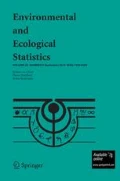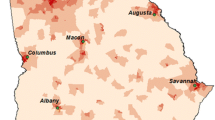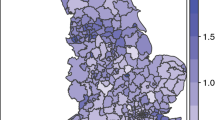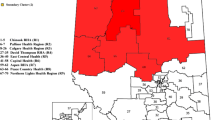Abstract
This paper extends the spatial local-likelihood model and the spatial mixture model to the space-time (ST) domain. For comparison, a standard random effect space-time (SREST) model is examined to allow evaluation of each model’s ability in relation to cluster detection. To pursue this evaluation, we use the ST counterparts of spatial cluster detection diagnostics. The proposed criteria are based on posterior estimates (e.g., misclassification rate) and some are based on post-hoc analysis of posterior samples (e.g., exceedance probability). In addition, we examine more conventional model fit criteria including mean square error (MSE). We illustrate the methodology with a real ST dataset, Georgia throat cancer mortality data for the years 1994–2005, and a simulated dataset where different levels and shapes of clusters are embedded. Overall, it is found that conventional SREST models fair well in ST cluster detection and in goodness-of-fit, while for extreme risk detection the local likelihood ST model does best.
Similar content being viewed by others
References
Agarwal DK, Gelfand AE, Citron-Pousty S (2002) Zero-inflated models with application to spatial count data. Environ Ecol Stat 9: 341–355 doi:10.1023/A:1020910605990
Besag J, York J, Mollie A (1991) Bayesian image restoration with two applications in spatial statistics (with discussion). Ann Inst Stat Math 43: 1–59 doi:10.1007/BF00116466
Best N, Richardson S, Thomas A (2005) A comparison of Bayesian spatial models for disease mapping. Stat Methods Med Res 14: 35–59 doi:10.1191/0962280205sm388oa
Clark AB, Lawson AB (2002) Spatio-temporal cluster modelling of small area health data, Ch 14. In: Lawson AB, Denison D(eds) Spatial cluster modelling. Chapman and Hall, London
Fernandez C, Green PJ (2002) Modelling spatially correlated data via mixtures: a Bayesian approach. J R Stat Soc B 64: 805–826 doi:10.1111/1467-9868.00362
Gamerman D, Lopes HF (2006) Markov chain Monte Carlo: stochastic simulation for Bayesian inference, 2nd edn. Chapman & Hall/CRC, Boca Raton, FL
Gelfand AE, Ghosh SK (1998) Model choice: a minimum posterior predictive loss. Biometrika 85: 1–11 doi:10.1093/biomet/85.1.1
Green PJ, Richardson S (2002) Hidden Markov models and disease mapping. J Am Stat Assoc 97: 1–16 doi:10.1198/016214502388618870
Haas TA (1995) Local prediction of a spatio-temporal process with an application to wet sulfate deposition. J Am Stat Assoc 90: 1189–1199 doi:10.2307/2291511
Higdon H (2007) A primer on space-time modeling from a Bayesian perspective, Ch 6. In: Finkenstadt B, Held L, Isham V(eds) Statistical methods for spatio-temporal systems. Chapman & Hall/CRC, Florida
Hossain MM, Lawson AB (2005) Local likelihood disease clustering: development and evaluation. Environ Ecol Stat 12: 259–273 doi:10.1007/s10651-005-1512-9
Hossain MM, Lawson AB (2006) Cluster detection diagnostics for small area health data: with reference to evaluation of local likelihood models. Stat Med 25: 771–786 doi:10.1002/sim.2401
Kauermann G, Opsomer JD (2003) Local likelihood estimation in generalized additive models. Scand J Stat 30: 317–337 doi:10.1111/1467-9469.00333
Kelsall JE, Wakefield JC (1999) Discussion of “Bayesian models for spatially correlated disease and exposure data” by Best et al. In: Bernardo JM, Berger JO, Dawid AP, Smith AFM(eds) Bayesian statistics 6. Oxford University Press, Oxford, p 151
Knorr-Held L (2000) Bayesian modelling of inseparable space-time variation in disease risk. Stat Med 19:2555–2567. doi:10.1002/1097-0258(20000915/30)19:17/18<2555::AID-SIM587>3.0.CO;2-#
Knorr-Held L, Besag J (1998) Modelling risk from a disease in time and space. Stat Med 17:2045–2060. doi:10.1002/(SICI)1097-0258(19980930)17:18<2045::AID-SIM943>3.0.CO;2-P
Lawson AB (2006) Cluster detection: a critique and a Bayesian proposal. Stat Med 25: 897–916 doi:10.1002/sim.2417
Lawson AB, Denison DGT (2002) Spatial cluster modeling: an overview, Ch 1. In: Lawson AB, Denison D(eds) Spatial cluster modelling. Chapman and Hall, Boca Raton, FL
R Development Core Team (2004) R: A language and environment for statistical computing. R Foundation for Statistical Computing, Vienna, Austria
Richardson S, Green PJ (1997) On Bayesian analysis of mixtures with an unknown number of components. J R Stat Soc B 59(4): 731–792 doi:10.1111/1467-9868.00095
Richardson S, Thomson A, Best N, Elliott P (2004) Interpreting posterior relative risk estimates in disease-mapping studies. Environ Health Perspect 112: 1016–1025
Spiegelhalter D, Best N, Carlin B, Linde A (2002) Bayesian measures of model complexity and fit (with discussion). J Roy Statist Soc Ser B Methodological 64: 583–639 doi:10.1111/1467-9868.00353
Spiegelhalter D, Thomas A, Best N, Lunn D (2003) WinBUGS user manual. MRC Biostatistics Unit. Institute of Public Health, Cambridge, UK
Author information
Authors and Affiliations
Corresponding author
Rights and permissions
About this article
Cite this article
Hossain, M.M., Lawson, A.B. Space-time Bayesian small area disease risk models: development and evaluation with a focus on cluster detection. Environ Ecol Stat 17, 73–95 (2010). https://doi.org/10.1007/s10651-008-0102-z
Received:
Revised:
Accepted:
Published:
Issue Date:
DOI: https://doi.org/10.1007/s10651-008-0102-z




